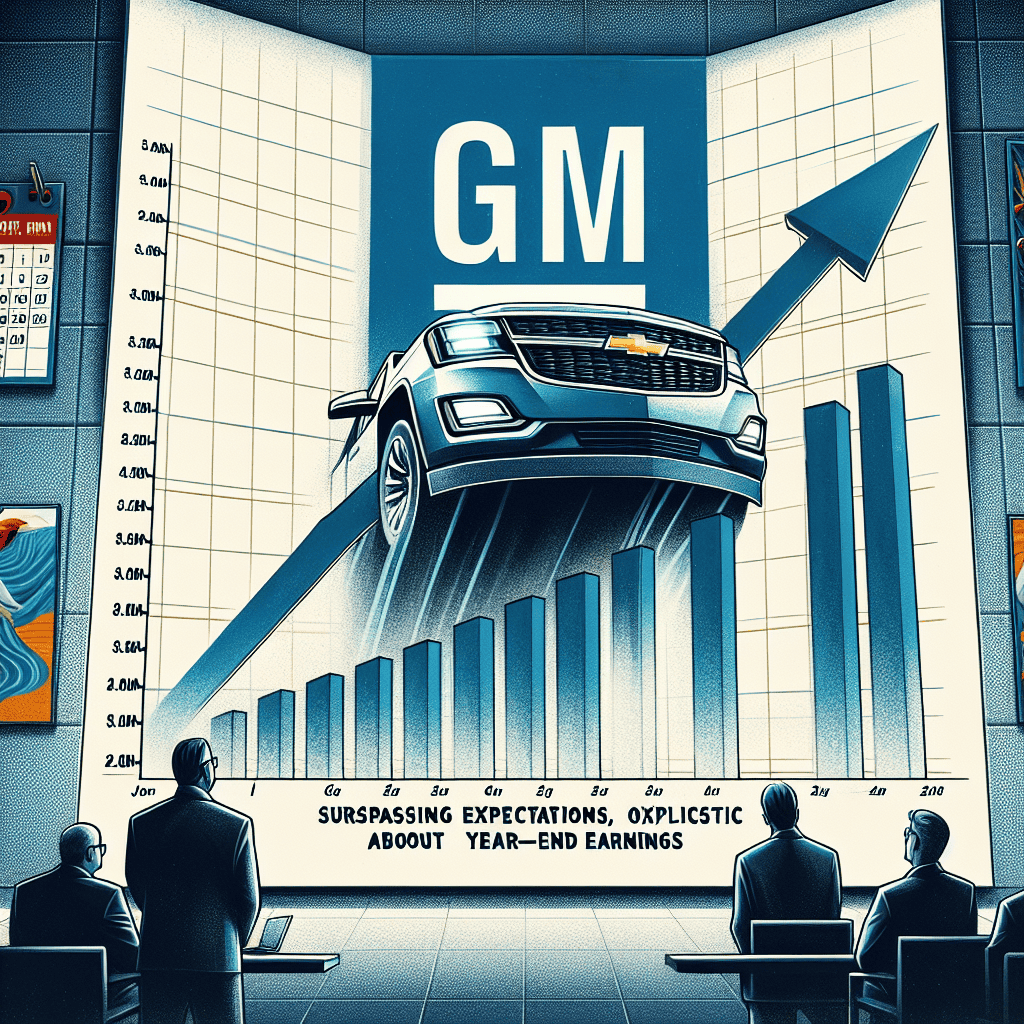“GM Accelerates Beyond Expectations, Driving Toward a Promising Year-End Finish!”
Introduction
General Motors (GM) has recently exceeded Wall Street’s expectations with its latest financial performance, signaling a robust outlook for the remainder of the fiscal year. The automotive giant reported stronger-than-anticipated earnings, driven by a combination of strategic initiatives, increased vehicle sales, and effective cost management. This positive financial outcome has bolstered investor confidence and positioned GM favorably as it approaches year-end. The company’s leadership has expressed optimism about sustaining this momentum, highlighting ongoing innovations in electric vehicles and advancements in autonomous driving technology as key drivers for future growth. As GM continues to navigate the evolving automotive landscape, its ability to outperform market predictions underscores its resilience and adaptability in a competitive industry.
GM’s Financial Triumph: Surpassing Wall Street Expectations
General Motors (GM) has recently reported financial results that have exceeded Wall Street’s expectations, marking a significant achievement for the automotive giant. This development comes at a time when the global automotive industry is navigating a complex landscape characterized by supply chain disruptions, fluctuating raw material costs, and evolving consumer preferences. Despite these challenges, GM’s robust performance underscores its strategic agility and operational resilience, positioning the company favorably as it approaches the end of the fiscal year.
The company’s latest financial disclosures reveal a notable increase in revenue and profit margins, driven by strong demand for its vehicles, particularly in the North American market. This demand has been bolstered by GM’s successful launch of new models and its continued focus on high-margin vehicles such as trucks and SUVs. Additionally, GM’s strategic investments in electric vehicles (EVs) and autonomous driving technology have begun to yield positive results, contributing to the company’s overall financial health. These investments are part of GM’s broader vision to lead the industry in the transition to sustainable transportation solutions.
Moreover, GM’s ability to navigate supply chain challenges has been a critical factor in its recent success. The company has implemented innovative strategies to mitigate the impact of semiconductor shortages, which have plagued the automotive industry for the past few years. By prioritizing the production of its most profitable models and leveraging its strong supplier relationships, GM has managed to maintain a steady production flow, ensuring that it can meet consumer demand effectively.
In addition to its operational strategies, GM’s financial management has played a pivotal role in surpassing Wall Street expectations. The company has maintained a disciplined approach to cost management, optimizing its production processes and reducing overhead expenses. This focus on efficiency has allowed GM to enhance its profitability, even as it invests heavily in future technologies. Furthermore, GM’s strong balance sheet and liquidity position have provided the company with the financial flexibility needed to navigate economic uncertainties and capitalize on growth opportunities.
Looking ahead, GM remains optimistic about its year-end earnings, buoyed by its strong performance in the first three quarters of the year. The company anticipates continued demand for its vehicles, supported by a robust product lineup and favorable market conditions. Additionally, GM’s ongoing commitment to innovation and sustainability is expected to drive long-term growth, as consumers increasingly prioritize environmentally friendly transportation options.
The company’s leadership has expressed confidence in GM’s strategic direction, emphasizing its focus on delivering value to shareholders while advancing its vision for the future of mobility. This confidence is reflected in GM’s plans to accelerate its EV rollout, with several new models slated for release in the coming months. As the company continues to invest in cutting-edge technologies and expand its EV portfolio, it is well-positioned to capture a significant share of the growing electric vehicle market.
In conclusion, GM’s ability to surpass Wall Street expectations is a testament to its strategic foresight, operational excellence, and financial acumen. As the company looks toward the future, it remains committed to driving innovation and delivering sustainable growth, ensuring that it remains a leader in the ever-evolving automotive industry. With a clear vision and a strong foundation, GM is poised to achieve its year-end earnings targets and continue its trajectory of success.
Analyzing GM’s Optimism for Year-End Earnings
General Motors (GM) has recently made headlines by surpassing Wall Street’s expectations, a development that has sparked optimism about its year-end earnings. This achievement is particularly noteworthy given the myriad challenges the automotive industry has faced in recent years, including supply chain disruptions, fluctuating raw material costs, and the ongoing transition to electric vehicles. As GM navigates these complexities, its recent performance offers a glimpse into the strategies that have enabled it to not only meet but exceed market predictions.
One of the key factors contributing to GM’s success is its robust product lineup, which has been strategically diversified to cater to a wide range of consumer preferences. The company has made significant investments in electric vehicles (EVs), a sector that is rapidly gaining traction as environmental concerns and regulatory pressures mount. By expanding its EV offerings, GM is positioning itself as a leader in the transition to sustainable transportation. This forward-thinking approach has not only enhanced its brand image but also attracted a new segment of environmentally conscious consumers, thereby boosting sales.
Moreover, GM’s focus on innovation extends beyond its product offerings. The company has been leveraging advanced technologies to streamline its manufacturing processes, improve efficiency, and reduce costs. By adopting automation and artificial intelligence, GM has been able to mitigate some of the supply chain challenges that have plagued the industry. These technological advancements have enabled the company to maintain production levels and meet consumer demand, even in the face of external disruptions.
In addition to its operational strategies, GM’s financial management has played a crucial role in its recent success. The company has implemented cost-control measures that have helped it maintain profitability despite rising input costs. By optimizing its supply chain and renegotiating supplier contracts, GM has been able to keep expenses in check, thereby protecting its bottom line. Furthermore, the company’s prudent capital allocation has allowed it to invest in growth initiatives while maintaining a healthy balance sheet.
As GM looks toward the end of the fiscal year, its leadership remains optimistic about the company’s earnings potential. This confidence is underpinned by several factors, including a strong order backlog and positive consumer sentiment. The automotive market is showing signs of recovery, with demand for both traditional and electric vehicles on the rise. GM’s ability to capitalize on this trend will be critical to its year-end performance.
However, it is important to acknowledge the potential challenges that could impact GM’s outlook. The global economic environment remains uncertain, with inflationary pressures and geopolitical tensions posing risks to the automotive industry. Additionally, the competitive landscape is intensifying as other automakers ramp up their EV offerings. To sustain its momentum, GM will need to continue innovating and adapting to these evolving market dynamics.
In conclusion, GM’s recent performance has exceeded Wall Street’s expectations, driven by a combination of strategic product diversification, technological innovation, and effective financial management. As the company approaches the end of the fiscal year, its optimism is well-founded, though not without challenges. By staying agile and responsive to market changes, GM is well-positioned to achieve its year-end earnings goals and maintain its leadership in the automotive industry.
Key Factors Behind GM’s Financial Success
General Motors (GM) has recently reported financial results that have surpassed Wall Street expectations, marking a significant milestone for the automotive giant. This achievement is attributed to a combination of strategic initiatives, market dynamics, and operational efficiencies that have collectively bolstered the company’s financial performance. As GM looks toward the end of the fiscal year, there is a palpable sense of optimism regarding its earnings potential.
One of the key factors contributing to GM’s financial success is its robust product lineup, which has resonated well with consumers. The company has made substantial investments in developing a diverse range of vehicles, including electric and hybrid models, which have gained considerable traction in the market. This strategic focus on innovation and sustainability has not only enhanced GM’s brand image but also expanded its customer base, thereby driving sales growth. Moreover, the introduction of new models with advanced features and cutting-edge technology has further strengthened GM’s competitive position in the automotive industry.
In addition to its product strategy, GM’s financial performance has been bolstered by its effective cost management practices. The company has implemented a series of measures aimed at optimizing its operations and reducing expenses. These initiatives have included streamlining production processes, renegotiating supplier contracts, and leveraging economies of scale. As a result, GM has been able to improve its profit margins, even in the face of rising raw material costs and supply chain disruptions that have affected the broader industry.
Furthermore, GM’s strategic partnerships and collaborations have played a pivotal role in its financial success. By forging alliances with technology companies and other industry players, GM has been able to accelerate its innovation efforts and enhance its product offerings. These partnerships have facilitated the development of new technologies, such as autonomous driving systems and connected vehicle solutions, which have positioned GM at the forefront of the automotive industry’s transformation. Consequently, these advancements have not only driven revenue growth but also opened up new revenue streams for the company.
Another significant factor contributing to GM’s strong financial performance is its focus on expanding its presence in key international markets. The company has made concerted efforts to increase its market share in regions such as China and Europe, where demand for vehicles remains robust. By tailoring its product offerings to meet the specific needs and preferences of consumers in these markets, GM has been able to capture a larger share of the global automotive market. This international expansion has provided a significant boost to GM’s overall sales and revenue figures.
As GM looks ahead to the end of the fiscal year, the company remains optimistic about its earnings potential. The combination of a strong product lineup, effective cost management, strategic partnerships, and international expansion has positioned GM for continued success. While challenges such as supply chain disruptions and economic uncertainties persist, GM’s proactive approach and strategic initiatives have equipped the company to navigate these obstacles effectively.
In conclusion, GM’s ability to surpass Wall Street expectations is a testament to its strategic vision and operational excellence. By focusing on innovation, cost efficiency, and market expansion, GM has not only strengthened its financial performance but also laid a solid foundation for future growth. As the company continues to execute its strategic initiatives, it remains well-positioned to achieve its year-end earnings targets and maintain its leadership position in the automotive industry.
GM’s Strategic Moves Leading to Financial Growth

General Motors (GM) has recently made headlines by surpassing Wall Street expectations, a testament to the company’s strategic maneuvers and robust financial planning. This achievement not only highlights GM’s resilience in a competitive automotive market but also sets a promising tone for its year-end earnings. The company’s success can be attributed to a combination of innovative product offerings, strategic partnerships, and a keen focus on operational efficiency.
To begin with, GM’s commitment to innovation has played a pivotal role in its financial growth. The company has been at the forefront of the electric vehicle (EV) revolution, investing heavily in research and development to produce cutting-edge EV models. This strategic focus aligns with the global shift towards sustainable transportation, allowing GM to capture a significant share of the burgeoning EV market. By introducing models that cater to a wide range of consumers, from luxury to budget-friendly options, GM has effectively broadened its customer base, thereby driving sales and revenue.
In addition to its product innovation, GM has also forged strategic partnerships that have bolstered its market position. Collaborations with technology firms and other automotive giants have enabled GM to leverage new technologies and expand its capabilities. For instance, partnerships in the realm of autonomous driving technology have positioned GM as a leader in this emerging field. These alliances not only enhance GM’s technological prowess but also provide access to new markets and customer segments, further fueling its growth.
Moreover, GM’s focus on operational efficiency has been instrumental in surpassing financial expectations. The company has implemented cost-cutting measures and streamlined its production processes, resulting in improved profit margins. By optimizing its supply chain and reducing overhead costs, GM has been able to maintain competitive pricing while ensuring high-quality products. This operational discipline has been crucial in navigating the challenges posed by global supply chain disruptions and fluctuating raw material costs.
Furthermore, GM’s strategic approach to market expansion has contributed significantly to its financial success. The company has been proactive in identifying and entering high-growth markets, particularly in Asia and Latin America. By tailoring its product offerings to meet the specific needs and preferences of these regions, GM has successfully tapped into new revenue streams. This geographic diversification not only mitigates risks associated with market volatility but also provides a stable foundation for sustained growth.
As GM looks towards the end of the fiscal year, the company remains optimistic about its earnings prospects. The combination of strong sales performance, strategic partnerships, and operational efficiency positions GM favorably to achieve its financial targets. Additionally, the company’s ongoing investments in technology and innovation are expected to yield long-term benefits, further enhancing its competitive edge.
In conclusion, GM’s ability to surpass Wall Street expectations is a reflection of its strategic foresight and adaptability in a rapidly evolving industry. By prioritizing innovation, forging strategic alliances, and maintaining operational excellence, GM has laid a solid foundation for continued financial growth. As the company continues to navigate the complexities of the global automotive market, its strategic initiatives are likely to drive sustained success, reinforcing its position as a leader in the industry.
Wall Street’s Reaction to GM’s Earnings Report
General Motors (GM) recently released its quarterly earnings report, which not only surpassed Wall Street’s expectations but also set a positive tone for the company’s outlook as the year draws to a close. This development has sparked considerable interest among investors and analysts, who are keen to understand the factors contributing to GM’s robust performance and the implications for the automotive industry at large.
To begin with, GM’s earnings report revealed a significant increase in revenue and profit margins, driven by strong sales in both domestic and international markets. The company’s strategic focus on electric vehicles (EVs) and autonomous driving technology has started to bear fruit, as evidenced by the growing demand for its new line of EVs. This shift towards sustainable transportation solutions has not only enhanced GM’s market position but also aligned it with global trends favoring environmentally friendly alternatives.
Moreover, GM’s ability to navigate supply chain disruptions, which have plagued the automotive industry over the past year, has been a critical factor in its success. By implementing innovative supply chain management strategies and forging strong partnerships with suppliers, GM has managed to maintain production levels and meet consumer demand. This resilience has been particularly noteworthy in the context of the semiconductor shortage, which has adversely affected many of its competitors.
In addition to operational efficiencies, GM’s financial performance has been bolstered by its strategic investments in technology and infrastructure. The company’s commitment to research and development has enabled it to introduce cutting-edge features in its vehicles, thereby enhancing their appeal to tech-savvy consumers. Furthermore, GM’s investment in charging infrastructure has facilitated the adoption of its EVs, providing a seamless experience for customers transitioning from traditional gasoline-powered vehicles.
As a result of these positive developments, Wall Street’s reaction to GM’s earnings report has been overwhelmingly favorable. Analysts have revised their forecasts for the company’s year-end earnings, with many expressing optimism about its growth prospects. The consensus is that GM is well-positioned to capitalize on the ongoing transformation of the automotive industry, particularly as it continues to expand its EV portfolio and explore new business models, such as ride-sharing and mobility services.
However, it is important to note that GM’s path forward is not without challenges. The company must continue to innovate and adapt to the rapidly changing landscape, where competition is intensifying, and consumer preferences are evolving. Additionally, regulatory pressures related to emissions and sustainability will require GM to remain vigilant and proactive in its approach.
In conclusion, GM’s recent earnings report has not only exceeded Wall Street’s expectations but also underscored the company’s strategic acumen and operational resilience. As it looks towards the end of the year, GM remains optimistic about its earnings potential, buoyed by strong market demand and a clear vision for the future. While challenges persist, the company’s ability to navigate them effectively will be crucial in maintaining its momentum and securing its position as a leader in the automotive industry. As investors and analysts continue to monitor GM’s progress, the company’s performance will undoubtedly serve as a bellwether for the broader market, offering valuable insights into the dynamics shaping the future of transportation.
Future Outlook: GM’s Path to Sustained Profitability
General Motors (GM) has recently reported financial results that have exceeded Wall Street’s expectations, marking a significant milestone in the company’s ongoing journey toward sustained profitability. This achievement is not only a testament to GM’s strategic initiatives but also a reflection of its resilience in navigating the complexities of the automotive industry. As the company looks toward the future, it remains optimistic about its year-end earnings, driven by a combination of innovative product offerings, strategic investments, and a keen focus on operational efficiency.
One of the key factors contributing to GM’s robust performance is its commitment to innovation, particularly in the realm of electric vehicles (EVs). The automotive giant has made substantial investments in EV technology, positioning itself as a leader in the transition to sustainable transportation. By expanding its EV lineup and enhancing battery technology, GM aims to capture a significant share of the growing market for electric vehicles. This strategic focus not only aligns with global trends toward sustainability but also promises to drive long-term profitability as consumer demand for EVs continues to rise.
In addition to its advancements in electric vehicles, GM has also prioritized the development of autonomous driving technology. By investing in cutting-edge research and forming strategic partnerships, the company is poised to play a pivotal role in the future of mobility. The integration of autonomous technology into GM’s product offerings is expected to open new revenue streams and enhance the overall customer experience, further solidifying the company’s competitive edge in the automotive sector.
Moreover, GM’s emphasis on operational efficiency has been instrumental in its ability to surpass financial expectations. Through cost-cutting measures and streamlined production processes, the company has managed to improve its profit margins despite the challenges posed by global supply chain disruptions. This focus on efficiency not only strengthens GM’s financial position but also enables it to reinvest in key areas of growth, ensuring a sustainable path to profitability.
As GM looks ahead to the end of the fiscal year, it remains confident in its ability to deliver strong earnings. The company’s optimistic outlook is supported by a robust pipeline of new vehicle launches, including several highly anticipated models that are expected to resonate with consumers. Furthermore, GM’s strategic initiatives in digital transformation and customer engagement are set to enhance its market presence and drive sales growth.
In conclusion, GM’s recent financial performance and optimistic year-end outlook underscore its commitment to sustained profitability. By leveraging its strengths in innovation, operational efficiency, and strategic investments, the company is well-positioned to navigate the evolving automotive landscape. As GM continues to execute its vision for the future, it remains focused on delivering value to shareholders and maintaining its status as a leader in the global automotive industry. With a clear path forward and a strong foundation in place, GM is poised to achieve its long-term financial goals and continue its legacy of excellence in the years to come.
Lessons from GM’s Financial Performance for the Auto Industry
General Motors (GM) has recently reported financial results that have exceeded Wall Street’s expectations, providing a beacon of optimism for the auto industry as it navigates a landscape marked by rapid technological advancements and shifting consumer preferences. This performance not only highlights GM’s strategic acumen but also offers valuable lessons for other automakers striving to thrive in a competitive market. As the industry grapples with the transition to electric vehicles (EVs) and the integration of advanced technologies, GM’s success underscores the importance of adaptability and forward-thinking strategies.
One of the key factors contributing to GM’s impressive financial performance is its robust investment in electric vehicles. By committing significant resources to the development and production of EVs, GM has positioned itself as a leader in the transition to sustainable transportation. This strategic focus has allowed the company to capture a growing segment of environmentally conscious consumers, thereby boosting its market share and revenue. For other automakers, GM’s approach serves as a reminder of the critical need to align product offerings with evolving consumer demands and regulatory requirements.
Moreover, GM’s ability to exceed expectations can be attributed to its agile supply chain management. In an era where supply chain disruptions have become increasingly common, GM has demonstrated resilience by diversifying its supplier base and implementing advanced technologies to enhance operational efficiency. This proactive approach has enabled the company to mitigate the impact of global supply chain challenges, ensuring a steady flow of products to market. Other automakers can learn from GM’s example by prioritizing supply chain resilience and investing in technologies that enhance flexibility and responsiveness.
In addition to its focus on EVs and supply chain management, GM’s financial success is also a testament to its commitment to innovation. The company has consistently invested in research and development, fostering a culture of innovation that has led to the creation of cutting-edge technologies and products. This emphasis on innovation has not only differentiated GM from its competitors but has also driven growth by attracting tech-savvy consumers. For the broader auto industry, GM’s experience highlights the importance of fostering a culture of innovation and investing in research and development to remain competitive in a rapidly evolving market.
Furthermore, GM’s optimistic outlook for year-end earnings reflects its strategic emphasis on cost management and operational efficiency. By streamlining operations and optimizing resource allocation, GM has been able to enhance profitability while maintaining high-quality standards. This focus on efficiency has allowed the company to weather economic uncertainties and maintain a strong financial position. Other automakers can draw valuable insights from GM’s approach by prioritizing cost management and operational excellence as key components of their strategic planning.
As the auto industry continues to evolve, GM’s financial performance offers a compelling case study in strategic foresight and adaptability. By embracing electric vehicles, enhancing supply chain resilience, fostering innovation, and prioritizing operational efficiency, GM has not only surpassed Wall Street expectations but has also set a benchmark for others in the industry. As automakers navigate the challenges and opportunities of the future, the lessons gleaned from GM’s success will undoubtedly serve as a guiding light, illuminating the path to sustainable growth and profitability.
Q&A
1. **What recent financial performance did GM report?**
GM recently reported financial results that surpassed Wall Street expectations.
2. **How did GM’s earnings compare to analyst predictions?**
GM’s earnings exceeded the predictions made by analysts.
3. **What is GM’s outlook for its year-end earnings?**
GM is optimistic about its year-end earnings.
4. **What factors contributed to GM’s better-than-expected performance?**
Factors may include strong vehicle sales, cost management, and successful new model launches.
5. **How did GM’s stock react to the earnings report?**
GM’s stock likely saw a positive reaction following the earnings report.
6. **What challenges does GM still face despite the positive earnings?**
GM may still face challenges such as supply chain issues and competition in the automotive market.
7. **What strategies is GM employing to maintain its positive momentum?**
GM is likely focusing on innovation, expanding its electric vehicle lineup, and improving operational efficiency.
Conclusion
General Motors (GM) has exceeded Wall Street’s expectations, showcasing a robust financial performance that has instilled confidence in its year-end earnings outlook. This achievement highlights GM’s strategic execution and operational efficiency, positioning the company favorably in the competitive automotive market. The optimistic forecast for year-end earnings suggests that GM is effectively navigating industry challenges, leveraging innovation, and capitalizing on consumer demand. As a result, GM’s strong performance not only reinforces its market position but also signals potential growth opportunities and shareholder value enhancement in the near future.





